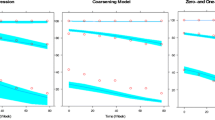Abstract
The fit of marginal models to longitudinal data should include modelling all extra variation among responses and covariates. This paper proposes a Partitioned Method of Valid Moments marginal regression model for binary outcomes with Bayes method while using lagged coefficients. Time-dependent covariates are factored in through composite likelihoods. A simulation study highlights the properties of the model coefficients. Modeling cognitive impairment diagnosis in NACC Alzheimer clinical data are demonstrated. Sensitivity analyses are conducted to evaluate the impact of the prior distribution on the posterior inferences.




Similar content being viewed by others
References
Beekly DL, Ramos EM, Erin M, et al (2007) The National Alzheimer’s Coordinating Center (NACC) database: the uniform dataset. https://www.alz.washington.edu/.
Chandler RE, Bate S (2007) Inference for clustered data using the independence loglikelihood. Biometrika 94(1):167–183
Cox DR, Reid N (2004) A note on pseudolikelihood constructed from marginal densities. Biometrika 91(3):729–737
Efron B (2015) Frequentist accuracy of Bayesian estimates. J R Stat Soc Ser B Stat Methodol 77(3):617–649
Glasbey CA (2001) Non-linear autoregressive time series with multivariate Gaussian mixtures as marginal distributions. J R Stat Soc Ser C Appl Stat 50(2):143–154
Hall AR (2005) Generalized method of moments. Oxford University Press, New York
Hansen LP (1982) Large sample properties of generalized method of moments estimators. Econometrica 50(4):1029–1054
Hansen LP, Heaton J, Yaron A (1996) Finite-sample properties of some alternative GMM estimators. J Bus Econ Stat 14(3):262–280
Heagerty PJ (2002) Marginalized transition models and likelihood inference for longitudinal cateogorical data. Biometrics 58(2):342–351
Heagerty PJ, Comstock BA (2013) Exploration of lagged associations using longitudinal data. Biometrics 69(1):197–205
Hoff PD (2009) A first course in bayesian statistical methods. Springer, New York
Hogervorst E, Hupper F, Matthews FE, Brayne C (2008) Thyroid function and cognitive decline in the MRC cognitive function and ageing study. Psychoneuroendocrinology 33(7):1013–1022
Irimata KM, Wilson JR. (2018) Using SAS to estimate lagged coefficients with the %partitionedGMM macro. In: SAS Global Forum 2018 conference proceedings. Denver.
Irimata KM, Broatch J, Wilson JR (2019) Partitioned GMM logistic regression models for longitudinal data. Stat Med 38(12):2171–2183
Joe H (1997) Multivariate models and dependence concepts. Chapman and Hall, London
Lai TL, Small D (2007) Marginal regression analysis of longitudinal data with time-dependent covariates: a generalised method of moments approach. J R Stat Soc Ser B 69(1):79–99
Laird NM, Ware JH (1982) Random-effects models for longitudinal data. Biometrics 38(4):963–974
Lalonde TL, Wilson JR, Yin J (2014) GMM logistic regression models for longitudinal data with time-dependent covariates. Stat Med 33(27):4756–4769
Liang K-Y, Zeger SL (1986) Longitudinal data analysis using generalized linear models. Biometrika 73(1):13–22
LoBue C, Denney D, Hynan LS et al (2016) Self-reported traumatic brain injury and mild cognitive impairment: Increased risk and earlier age of diagnosis. J Alzheimers Dis 51(3):727–736
McFadden D (1989) A method of simulated moments for estimation of discrete response models without numerical integration. Econometrica 57(5):995–1026
Muller H-G, Stadtmuller U (2005) Generalized functional linear models. Ann Stat 33(2):774–805
Obermeier V, Scheipl F, Heumann C, Wassermann J, Küchenhoff H (2015) Flexible distributed lags for modelling earthquake data. J R Stat Soc Ser C Appl Stat 64(2):395–412
Paterniti S, Verdier-Taillefer MH, Dufouil C, Alperovich A (2002) Depressive symptoms and cognitive decline in elderly people. Br J Psychiatry 181:406–410
Qu A, Lindsay BG, Li B (2000) Improving generalised estimating equations using quadratic inference functions. Biometrika 87(4):823–836
Rocca WA, Petersen RC, Knopman DS et al (2011) Trends in the incidence and prevalence of Alzheimer’s disease, dementia and cognitive impairment in the United States. Alzheimers Dement 7(1):80–93
Roos M, Held L (2011) Sensitivity analysis in Bayesian generalized linear mixed models for binary data. Bayesian Anal 6(2):259–278
Schildcrout JS, Heagerty PJ (2005) Regression analysis of longitudinal binary data with time-dependent environmental covariates: bias and efficiency. Biostatistics 6(4):633–652
Skene AM, Shaw JEH, Lee TD (1986) Bayesian modelling and sensitivity analysis. J R Stat Soc Stat 35(2):281–288
Stein ML, Chi Z, Welty LJ (2004) Approximating likelihoods for large spatial data sets. J R Stat Soc Ser B Stat Methodol. 66(2):275–296
Tanaka M (2020) Adaptive MCMC for generalized method of moments with many moment conditions.
Varin C (2008) On composite marginal likelihoods. AStA Adv Stat Anal 92:1–28
Varin C, Reid N, Firth D (2011) An overview of composite likelihood methods. Stat Sin 21(1):5–42
Yin G (2009) Bayesian generalized method of moments. Bayesian Anal 4(2):191–207
Yin G, Ma Y, Liang F, Yuan Y (2011) Stochastic Generalized Method of Moments. J Comput Graph Stat 20(3):714–727
Zeger SL, Liang K-Y (1986) Longitudinal data analysis for discrete and continuous outcomes. Biometrics 42(1):121–130
Author information
Authors and Affiliations
Corresponding author
Additional information
Publisher's Note
Springer Nature remains neutral with regard to jurisdictional claims in published maps and institutional affiliations.
Rights and permissions
About this article
Cite this article
Vazquez, E., Wilson, J.R. Partitioned method of valid moment marginal model with Bayes interval estimates for correlated binary data with time-dependent covariates. Comput Stat 36, 2701–2718 (2021). https://doi.org/10.1007/s00180-021-01105-3
Received:
Accepted:
Published:
Issue Date:
DOI: https://doi.org/10.1007/s00180-021-01105-3




